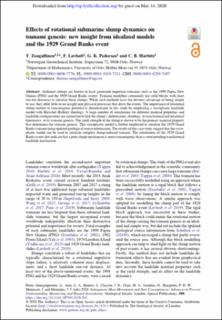Effects of rotational submarine slump dynamics on tsunami-genesis – new insight from idealized models and the 1929 Grand Banks event
Peer reviewed, Journal article
Published version
Permanent lenke
https://hdl.handle.net/11250/2654534Utgivelsesdato
2020Metadata
Vis full innførselSamlinger
- NGI articles [1037]
Originalversjon
10.1144/SP500-2019-201Sammendrag
Sediment slumps are known to have generated important tsunamis such as the 1998 Papua New Guinea (PNG) and the 1929 Grand Banks events. Tsunami modellers commonly use solid blocks with short run-out distances to simulate these slumps. While such methods have the obvious advantage of being simple to use, they offer little or no insight into physical processes that drive the events. The importance of rotational slump motion to tsunamigenic potential is demonstrated in this study by employing a viscoplastic landslide model with Herschel-Bulkley rheology. A large number of simulations for different material properties and landslide configurations are carried out to link the slump's deformation, rheology, its translational and rotational kinematics, to its tsunami-genesis. The yield strength of the slump is shown to be the primary material property that determines the tsunami-genesis. This viscoplastic model is further employed to simulate the 1929 Grand Banks tsunami using updated geological source information. The results of this case study suggest that the viscoplastic model can be used to simulate complex slump induced tsunami. The simulations of the 1929 Grand Banks event also indicate that a pure slump mechanism is more tsunamigenic than a corresponding translational landslide mechanism.
